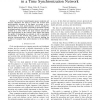AICT
2005
IEEE
14 years 12 months ago
2005
IEEE
Clock synchronization has paid a great magnitude of attention in the distributed systems. Sensor networks differ from traditional distributed system in many ways. One of the drama...
ICNP
2006
IEEE
15 years 10 days ago
2006
IEEE
— In a wormhole attack, wireless transmissions are recorded at one location and replayed at another, creating a virtual link under attacker control. Proposed countermeasures to t...
GLOBECOM
2006
IEEE
15 years 11 days ago
2006
IEEE
— As Internet computing gains speed, complexity and becomes ubiquitous, the need for precise and accurate time synchronization increases. In this paper, we present a characteriza...
WDAG
2007
Springer
15 years 12 days ago
2007
Springer
Consider a distributed network of n nodes that is connected to a global source of “beats”. All nodes receive the “beats” simultaneously, and operate in lock-step. A scheme ...
SSS
2007
Springer
15 years 12 days ago
2007
Springer
Abstract. In sensor networks, correct clocks have arbitrary starting offsets and nondeterministic fluctuating skews. We consider an adversary that aims at tampering with the cloc...
ISPAN
2009
IEEE
15 years 29 days ago
2009
IEEE
— Since WSNs have restricted energy sources, the energy efficiency of a synchronization scheme is as important as the accuracy of a clock. To accomplish both the energy efficienc...
DATE
2009
IEEE
15 years 1 months ago
2009
IEEE
—Distributed systems, especially time-triggered ones, are implementing clock synchronization algorithms to provide and maintain a common view of time among the different nodes. S...
SENSYS
2009
ACM
15 years 1 months ago
2009
ACM
Clock synchronization is highly desirable in many sensor networking applications. It enables event ordering, coordinated actuation, energy-efficient communication and duty cyclin...
SOFSEM
2010
Springer
15 years 3 months ago
2010
Springer
Clock synchronization is one of the most basic building blocks for many applications in computer science and engineering. The purpose of clock synchronization is to provide the con...

